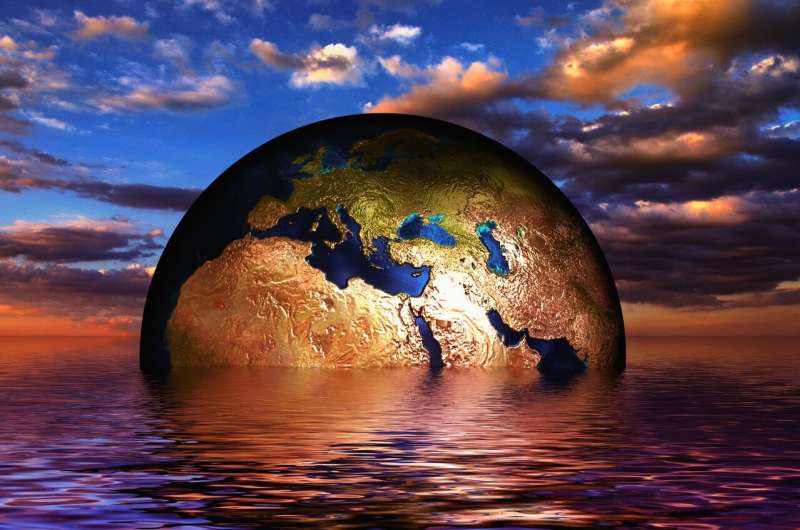This article has been reviewed according to Science X's editorial process and policies. Editors have highlighted the following attributes while ensuring the content's credibility:
fact-checked
trusted source
written by researcher(s)
proofread
Researchers: The climate change we caused is here for at least 50,000 years—and probably far longer

In February 2000, Paul Crutzen rose to speak at the International Geosphere-Biosphere Programme in Mexico. And when he spoke, people took notice. He was then one of the world's most cited scientists, a Nobel laureate working on huge-scale problems—the ozone hole, the effects of a nuclear winter.
So little wonder that a word he improvised took hold and spread widely: this was the Anthropocene, a proposed new geological epoch, representing an Earth transformed by the effects of industrialized humanity.
The idea of an entirely new and human-created geological epoch is a sobering scenario as context for the current UN climate summit, COP28. The impact of decisions made at these and other similar conferences will be felt not just beyond our own lives and those of our children, but perhaps beyond the life of human society as we know it.
The Anthropocene is now in wide currency, but when Crutzen first spoke, this was still a novel suggestion. In support of his new brain-child, Crutzen cited many planetary symptoms: enormous deforestation, the mushrooming of dams across the world's large rivers, overfishing, a planet's nitrogen cycle overwhelmed by fertilizer use, and the rapid rise in greenhouse gases.
As for climate change itself, well, the warning bells were ringing, certainly. Global mean surface temperatures had risen by about half a degree since the mid-20th century. But, they were still within the norm for an interglacial phase of the ice ages. Among many emerging problems, climate seemed one for the future.
A little more than two decades on, the future has arrived. By 2022, global temperature had climbed another half a degree, the past nine years being the hottest since records began. And 2023 has seen climate records being not just broken, but smashed.
By September there had already been 38 days when global average temperatures exceeded pre-industrial ones by 1.5°C, the safe limit of warming set by the UN Convention on Climate Change (UNFCCC) in the Paris agreement. In previous years that was rare, and before 2000 this milestone had never been recorded.
With this leap in temperatures came record-breaking heat waves, wildfires and floods, exacerbated by other local human actions. Climate has moved center stage on an Anthropocene Earth.
Why this surge in temperatures? In part, it's been the inexorable rise in greenhouse gases, as fossil fuels continue to dominate human energy use. When Crutzen spoke in Mexico, atmospheric carbon dioxide levels were about 370 parts per million (ppm), already up from the pre-industrial 280 ppm. They're now around 420 ppm, and climbing by some 2 ppm per year.
In part, the warming results from cleaner skies in the past few years, both on land and at sea, thanks to new regulations phasing out old power stations and dirty sulfur-rich fuels. As the industrial haze clears, more of the sun's energy makes it through the atmosphere and onto land, and the full force of global warming kicks in.
In part, our planet's heat-reflecting mirrors are shrinking, as sea ice melts away, initially in the Arctic, and in the last two years, precipitously, around Antarctica too. And climate feedbacks seem to be taking effect, too. A new, sharp rise in atmospheric methane—a far more potent greenhouse gas than carbon dioxide—since 2006 seems to be sourced from an increase in rotting vegetation in tropical wetlands in a warming world.
This latest warming step has already taken the Earth into levels of climate warmth not experienced for some 120,000 years, into those of the last interglacial phase, a little warmer than the current one. There is yet more warming in the pipeline over coming centuries, as various feedbacks take effect.
A recent study on the effects of this warming on Antarctica's ice suggests that "policymakers should be prepared for several meters of sea-level rise over the coming centuries" as the pulse of warmth spreads through the oceans to undermine the great polar ice-sheets.
This remains the case even in the most optimistic scenario where carbon dioxide emissions are reduced quickly. But emissions continue to rise steeply, to deepen the climate impact.
Controls have been overridden
To see how this might play out on a geological timescale, we need to look through the lens of the Anthropocene. A delicately balanced planetary machinery of regular, multi-millennial variations in the Earth's spin and orbit has tightly controlled patterns of warm and cold for millions of years.
Now, suddenly, this control machinery has been overridden by a trillion tons of carbon dioxide injected into the atmosphere in little more than a century.
Modeling the effects of this pulse through the Earth System shows that this new, suddenly disrupted, climate pattern is here for at least 50,000 years and probably far longer. It's a large part of the way our planet has changed fundamentally and irreversibly, to become comparable to some of the great climate change events in deep Earth history.
So will this particular COP meeting, with fossil fuel interests so strongly represented, make a difference? The bottom line is that attaining, and stabilizing carbon emissions at "net zero" is only a crucial first step.
To retrieve the kind of climate optimal for humanity, and for life as a whole to thrive, negative emissions are needed, to take carbon out of the atmosphere and ocean system and put it back underground. For future generations, there is much at stake.
Provided by The Conversation
This article is republished from The Conversation under a Creative Commons license. Read the original article.![]()





















